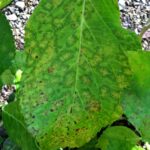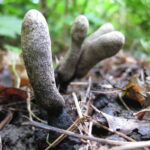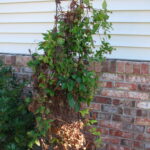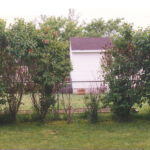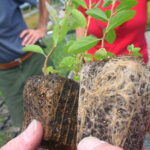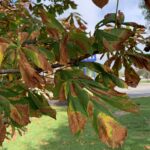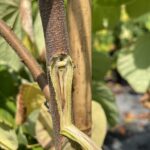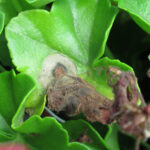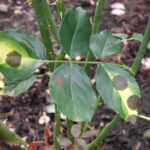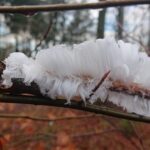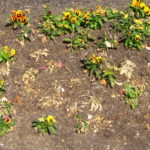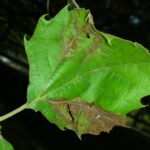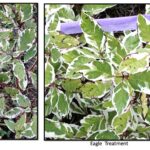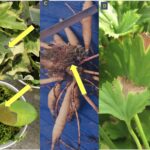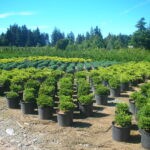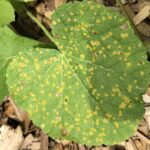Hydrangea L. (family Hydrangeaceae Dumort) is an all-encompassing description of a group of herbaceous and woody flowering plants, composed of more than 80 species native to Asia (including Japan), Indonesia, the Americas. Popular hydrangea species include the bigleaf hydrangea (Hydrangea macrophylla), also known as French hydrangea, panicled (peegee) hydrangea (H. paniculata), oak-leaf hydrangea (H. quercifolia) and mountain hydrangea (H. serrata). Hydrangea[Read More…]
Dead man’s fingers is an apt moniker for a gruesome-looking fungus (Xylaria polymorpha and related species) that produces club-shaped fungal fruiting bodies that appear as fingers growing around the base of dying or dead woody plants and even wooden objects in soil (Fig. 1). With more than 25 species of Xylaria, generalizations are difficult to[Read More…]
Wet summer weather always brings in a surplus of plant diseases, but few are as dramatic as clematis blight, caused by the fungus now called Calophoma clematidina (formerly Ascochyta or Phoma clematidina) (Fig. 1). The rest of us simply call it clematis blight or clematis wilt. Why the confusion with both the common and Latin[Read More…]
All plants are susceptible to attack by pests and pathogens. Under certain conditions, a homeowner may require the use of a pesticide, but only after they’ve included, or exhausted the use of cultural practices like removal of diseased tissue (sanitation and eradication); considered resistant varieties to replace continual problem plants; and making sure the plant[Read More…]
Pseudomonas syringae pv. syringae is an opportunistic bacterial pathogen that attacks a diversity of woody ornamental plants. The bacteria cause flower blights, cankers, shoot blights, and diebacks. Symptoms Symptoms often begin as expanding leaf spots. On lilac and viburnum, small spots expand to irregularly shaped brown lesions with yellow halos (Fig. 1). For most other hosts[Read More…]
Why Scout? Pathogens, insects, weeds and other pests negatively impact ornamental plant production (greenhouse, nursery, landscape). Integrated pest management (IPM) strategies are used to prevent (ideally) or mitigate damage to ornamental crops. IPM strategies of ornamentals include practices such as proper plant choice for the site, incorporation of resistant varieties when available, the use of[Read More…]
Guignardia leaf blotch infects Aesculus species, which include the native plants Ohio buckeye (A. glabra), bottlebrush buckeye (A. parviflora), along with the less common painted buckeye (A. sylvatica) and red (A. pavia) buckeye. The non-native horse-chestnut (A. hippocastanum) is also a susceptible host of this disease (Fig. 1). Symptoms The fungus Guignardia aesculi (pronounced Gwin-yard-ee uh)[Read More…]
All plants can fall victim to insects, diseases, and environmental problems. How they respond to this stress is often the same: Wilting, yellowing, holes, rots, blight—it’s a long list! With so much overlap in symptoms, it can be quite a challenge for people to identify their plant health problems accurately, quickly, and inexpensively. The Purdue[Read More…]
The Problem In recent years, nurseries in multiple states have reported moderate to severe dieback, chlorosis and stunting of redbud (Fig. 1). Dieback is defined as “the gradual but progressive death of individual branches or shoots from tips toward the main stem.” Dieback is a catch-all phrase that describes a constellation of symptoms that include[Read More…]
Botrytis blight (also called grey mold) is caused by fungi in the genus Botrytis. The best known of these fungi, Botrytis cinerea, can infect many different hosts, including soft fruit, vegetables, annuals, perennials, shrubs and young tree seedlings (Fig. 1). Other common species of Botrytis are more host specific, including Botrytis elliptica (infecting only lilies[Read More…]
Roses are a popular landscape and garden plant in Indiana. Black spot, caused by the fungus Diplocarpon rosae, is the major foliar disease of roses in Indiana. Infected leaves develop black spots, turn yellow and drop prematurely from the plant. Premature defoliation decreases plant energy reserves and results in reduced flowering of roses as well[Read More…]
Hair ice, also called ice wool, frost beard, and gnome beard is ice that appears like silky hair (Fig. 1) but forms on dead wood colonized by the fungus Exidiopsis effusa. It is fairly uncommon and not reported in Indiana…but who has been looking for it? Think of the bragging rights! It has been found as[Read More…]
Black root rot (BRR), caused by the fungus Thielaviopsis basicola,has a host range of several hundred plants. In the landscape, the most common hosts include pansies (Fig. 1), and vinca, along with calibrachoa and petunia. In perennial hosts, it often infects lavender, phlox, milkweed and butterfly-weed (Asclepius spp.). Even woody plants, like holly and elderflower[Read More…]
While fungi are responsible for many of our foliar disease problems, different fungal pathogens present as problems throughout the country, depending upon the host plant grown and the environmental conditions. This is a brief overview of several common types of fungal leaf diseases occur in Indiana and throughout North America (and Europe). Recognizing the symptoms[Read More…]
Fungicides are important tools for managing ornamental plant diseases (Fig. 1). There are many different fungicides and numerous methods of classifying them. One way to classify fungicides is by their chemical structures or modes of action — the specific ways the fungicides kill a fungus. Fungicides that share a common mode of action belong to[Read More…]
For many of us, pest management is never far from our mind. This may be because the pests we manage are always there, and even if we can’t see them, we know that they haven’t disappeared completely. For this reason, it is important to take a time-out and think about how to improve your management,[Read More…]
As the 2020 gardening year draws to a close, now is the time to ensure a successful gardening season next year, for you or your customers! Sanitation is a cornerstone of integrated pest management and is essential for good plant health management. Throughout the year, we have been plagued with both unusually wet and unusually[Read More…]
Hollyhock (Alcea spp.), an anchor plant for the back of the cottage garden, bloom mid-summer with numerous flowers on tall spikes, providing beauty for us, and food for bees, hummingbirds and butterflies. The most common varieties are biennial, taking two years to complete their lifecycle, although some persist as short-lived perennials. Fortunately, they are prolific[Read More…]

